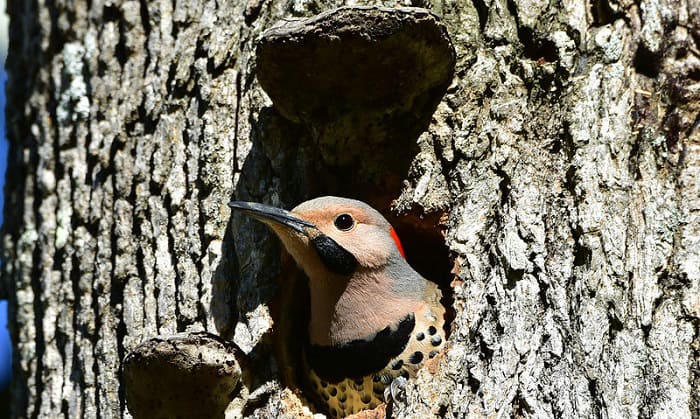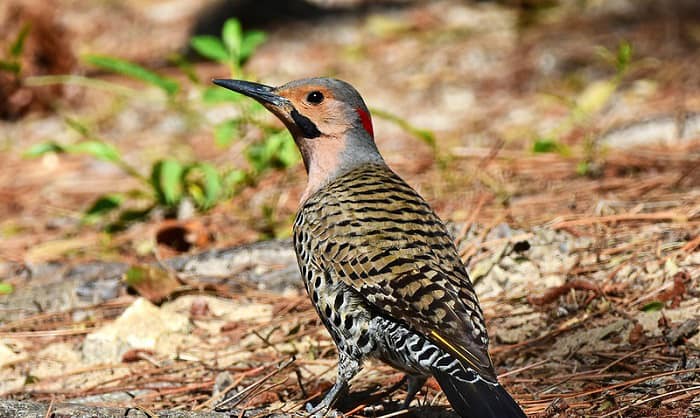The northern flicker is the right answer to your question about what is the state bird of Alabama. It was on September 6, 1927 that the bill was passed by Gov. Bibb Graves to make the yellowhammer as the legislative bird.
The nickname “Yellowhammer State” started to emerge in the Civil War. This was because of the yellow troop uniforms. And ’till this day, Alabama is distinguishable for its yellow color in both the state bird and cavalry uniform.
Table of Contents
What You Need to Know About the Northern Flicker
The state bird and flower of the Yellowhammer State are the northern flicker and camellia, respectively. There is also an official game bird which is the eastern wild turkey. But to be clear, the state bird and state game bird don’t share the same limelight.
Yellowhammers are known to have a sweet side. The symbols that these birds represent are worthy of their state bird status. Plus, they are monogamous avians, which is a good reflection of the state’s residents.
Yellowhammers are woodpeckers and are expected to live all the time in trees. But these yellow birds are ground-dwellers. They build their nests on the ground, hidden in bushes.
And they prefer to forage the soil for food such as ants, bugs, and insects.
The Yellowhammer
The head and bottoms of the male yellowhammer are colored yellow. Their back is brown with specks of black, and their behind has a rusty hue.
As for the females, their plumage is a combination of yellow, black, orange, brown, and cream. And for both genders, the leg colors are pink and brown.
- Length – 11-14 inches
- Wingspan – 17-21 inches
- Weight – 86-167 grams
- Wing bone – 4.8-6.7 inches
- Tail – 3-4.5 inches
- Bill – 0.87-1.69 inches
- Tarsus – 0.87-1.22 inches
To get to know northern flickers better, let’s look at a few pictures and images.
Facts About the Yellowhammer
Scientific classification:
- Kingdom – Animalia
- Family – Picidae
- Order – Piciformes
- Class – Aves
- Genus – Colaptes
- Phylum – Chordata
- Species – C. auratus
- Binomial name – Colaptes auratus
The northern flickers are no doubt exciting and fascinating to get to know. Learning about the facts about this adorable bird helps bird enthusiasts like you to understand yellowhammers better.
1. Appearance and absence
The Alabama’s state bird appears during the winter season, where its yellow plumage amazes birders.
However, during the summer, when breeding season comes, the yellowhammers are mostly out of sight. So, the best time to get acquainted with the northern flickers is when the weather is freezing.
2. Recognized names
The name northern flicker is the official term for the state bird of Alabama.
But this bird species is also known for other names. They include yellow-shafted flicker, yellowhammer, flicker, common flicker, and southern flicker. But in this state, this bird is mainly referred to as a yellowhammer.
3. Ant-eater
Northern flickers have their diet of insects and fruits, but they like ants more. They come out during the winter to hunt for ants on the ground.
And that’s when bird enthusiasts are able to see these birds in their yards. It’s important to note that not all birds can eat ants.
4. Communication
The yellowhammer state takes pride in the way that the northern flickers communicate. The yellowhammers learn regional dialects from their dads. Alabama flickers have songs such as:
- “zit” – communicating with other avians
- “see” – warn other birds of danger
- “tirrr” – sound when flying
5. Lifespan
The yellowhammers are obviously beautiful, birds and bird lovers would like to see them live a long life.
However, the northern flickers have a short lifespan of three years. They lay numerous eggs, thrive in this world, and then either get killed by predators or reach the end of their lives.
6. Interbreeding
The flickers have two subspecies, which are the yellow-shafted flickers and the red-shafted birds. The former is the official state bird of Alabama, while the latter is mostly found in the western regions. And though it does not happen often, both species do interbreed.
7. Flock
A flock of northern flickers consists of hundreds of avians, which does not only contain yellowhammers. You can also find finches and buntings in a flock of Alabama woodpeckers feeding on insects on the ground.
8. Tree choice
Yellowhammers don’t have strong beaks, which is kind of ironic since they’re woodpeckers. They choose trees that are dead or with soft bodies to peck and build their roosting nest. This bird species cannot handle strong and hardwood.
9. Diet And Predators
The yellowhammers have a diet that consists of nuts, bugs, berries, fruits, ants, caterpillars, spiders, snails, seeds, termites, grasshoppers, moths, butterflies, and beetles.
Also, it’s interesting to know that northern flickers can consume poison ivy and poison oak without being harmed.
On a regular basis, 45% of their food intake is composed of ants. In fact, yellowhammers are known to raid ant colonies and munch on a couple of ants at the same time. And they can do this thanks to their lengthy tongue that can dart out in 2 inches.
The “anting” activity of the northern flickers allows them to acquire ant’s formic acid. This substance protects the woodpeckers from parasites. But, they’re not free from their common predators, which are the tree-climbing snakes and hawks.
10. Breeding Information
The breeding period of the yellowhammer species starts with courtship in April or May and can continue until August. The northern flickers have their regional dialect, and the males use them to attract mates.
Female yellowhammers decide which male to mate with through their singing and speaking prowess.
Woodland edges and hedges are the usual breeding spots of yellowhammers.
The Alabama woodpeckers live in trees, but these monogamous bird lovers create a ground love nest. Females use dry leaves, grass, stalks, and animal hair for their nests.
The entry point of the nest has a diameter of 3”, and the depth of the cavity is 13-16”. Aside from the ground, yellowhammers also build their nests in dead tree branches.
- Clutch size – 5-8 eggs
- Brood number – 1 brood
- Egg width – 0.6-1.3 inches
- Egg length – 0.8-1.4 inches
- Nesting period – 24-27 days
- Incubation time – 11-13 days
- Egg appearance – white
- Hatchling conditions – pink skin, shut eyes, clumsy, egg tooth, naked
Conclusion
What is the state bird of Alabama is an important knowledge to learn about. The Yellowhammer State passed the legislative bill to make the northern flicker the state bird in 1927.
Northern flickers are more popularly known as the yellowhammers, and they’re a woodpecker. And though they reside in trees, this bird species nests on the ground.
The yellowhammers are distinguishable with their yellow color. They are fond of eating ants, and they mate for life.
We hope you learned new things about the northern flickers. Please take time to share on your social media.
Before you go, don’t forget to check out these related posts to other state birds:
- What is the state bird of Montana?
- Some facts of the California gull of Utah.
- The symbol bird of Georgia.

George and I became friends after a birdwatching trip with our new group. And we have been enjoying every adventure together. When he told me the idea of establishing a site that shares our experiences and fun, I immediately agreed. After trials and errors, here we have Thayerbirding.
















